Dragonfly Partners: Why have all low liquidity/high FDV tokens dropped?
Original Title: Why are all these low float / high FDV coins down bad?
Author: Haseeb, Partner at cryptocurrency venture fund Dragonfly
Translation by: Elvin, ChainCatcher
Editor’s Note:
The discussion around "high FDV low float tokens" has been heated these days, with many opinions suggesting that VC tokens are the culprits behind this round of "no one picking up the bull market." Haseeb, a partner at the cryptocurrency venture fund Dragonfly, uses data to refute some of these views, and he believes that for VCs, when project valuations reach astronomical numbers, they also face unlocking dilemmas. This leads LPs to perceive this asset class as fraudulent; although it looks good on paper, it is actually terrible, and VCs do not want this. A gradual and stable increase in asset prices over time is what most people hope for.
Has the market structure been broken? Are VCs too greedy? Is this a manipulated game in the secondary market?
Almost all theories I have seen regarding this issue seem to be wrong. But I will let the data speak.
This is a notorious table that has been circulating, sourced from @tradetheflow_, showing that a batch of tokens recently listed on Binance are all down. Most of them have been mocked as "high FDV (fully diluted value), low float" tokens, meaning they have a relatively high FDV valuation but very little circulating supply on the first day.
 I plotted all of these into a chart and removed the labels. I excluded any relevant MEME coins, as well as tokens that had TGE long before Binance, such as RON and AXL. Its appearance is as follows, with BTC (beta) in yellow:
I plotted all of these into a chart and removed the labels. I excluded any relevant MEME coins, as well as tokens that had TGE long before Binance, such as RON and AXL. Its appearance is as follows, with BTC (beta) in yellow:
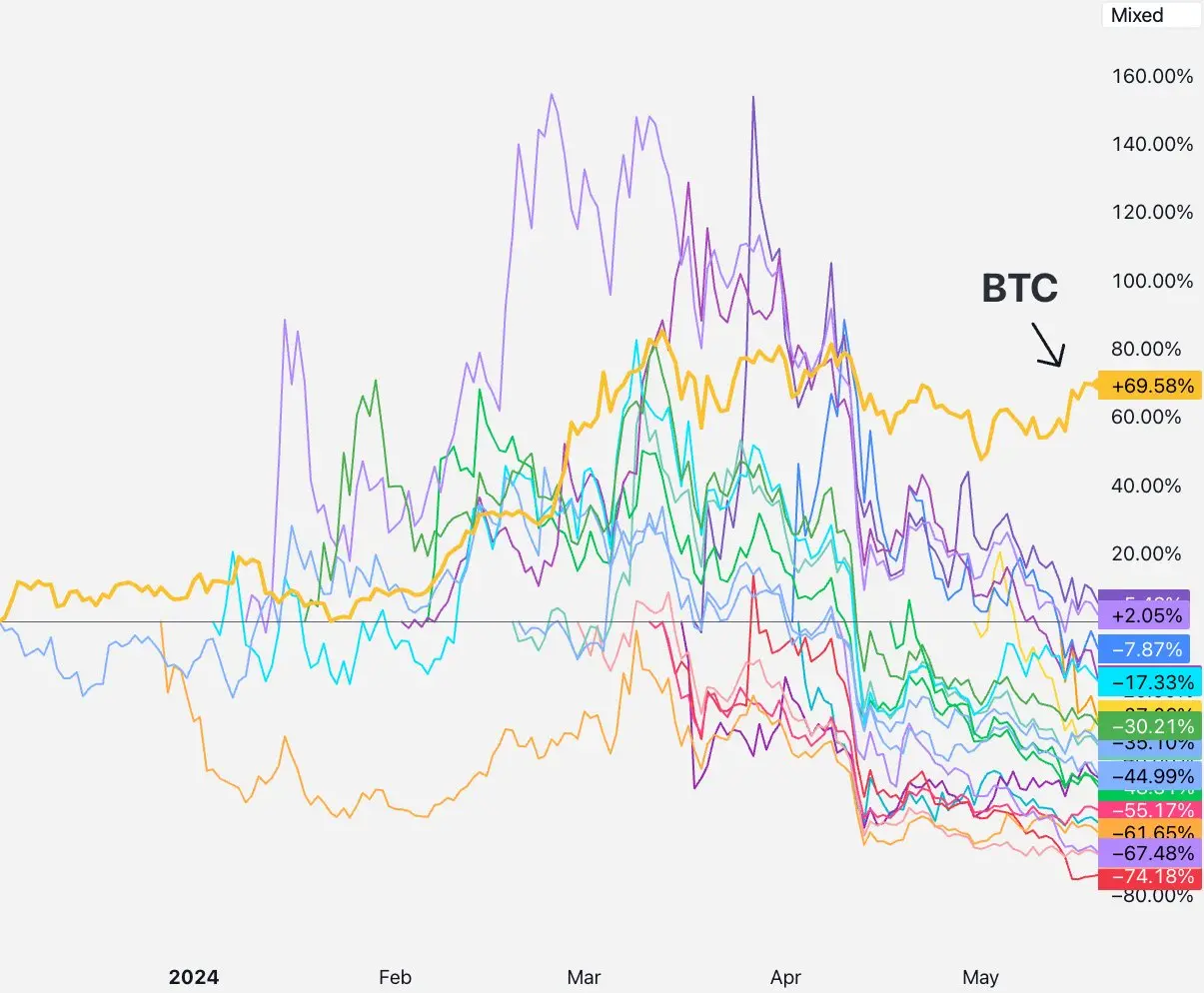
These "low float, high FDV" Binance-listed projects have almost all declined. What could explain this? Everyone has their own favorite theory regarding the destruction of market structure. The three most popular theories are:
1) VCs/KOLs are dumping into the secondary market
2) The secondary market is angrily dumping these tokens and only buying meme coins
3) The supply is too low for meaningful price discovery
Each has some merit! Let's see if they hold true. But to maintain scientific rigor, we need a null hypothesis to refute. Our null hypothesis should be: these assets are being repriced, but there are no deeper market structure issues. (Classic "in the end, sellers always outnumber buyers.")
We will discuss each theory one by one.
1) VCs/KOLs are dumping into the secondary market
If there is a story here, what should it look like?
We should see tokens with shorter lock-up periods being sold off faster than others, while projects with longer lock-up periods or no KOLs should perform well. (High liquidity perpetual contracts could also be another vehicle for this dumping.)
So what did we see in the data?
 From the data in the above chart, we can see that from listing until early April, the tokens actually performed well—some above the listing price, some below, but most clustered around the zero axis. Before this, it seems no VC or KOL had sold off.
From the data in the above chart, we can see that from listing until early April, the tokens actually performed well—some above the listing price, some below, but most clustered around the zero axis. Before this, it seems no VC or KOL had sold off.
Then in mid-April, everything started to decline. Despite these projects being listed on many different dates and having many different VCs and KOLs, did all these projects unlock in mid-April and start dumping into the secondary market?
Let me share my perspective here. I am a VC. There are definitely VCs dumping into the secondary market—there are also VCs not locking up, hedging over-the-counter, or even breaking lock-ups, but these are low-tier VC firms, and most teams working with these venture capital firms are not selling on major exchanges. Every top-tier VC firm you can think of has at least a one-year cliff and several years of vesting before they receive tokens. In fact, under the 144a rule, a one-year cliff is mandatory for anyone or any institution regulated by the SEC. Additionally, for large VC firms like ours, our positions are too large to hedge over-the-counter, and we are usually obligated to unlock early according to contracts.
So this is why this story doesn't make sense: every one of these tokens is less than a year away from TGE, meaning VCs with a one-year cliff are still locked up!
Maybe some of these low-tier VC projects sold tokens early, but all projects are down, even those still locked up by top VC investments.
Therefore, for some tokens, the dumping by investors/KOLs may be true—there are always some projects with bad behavior. But if all tokens are down simultaneously, this theory cannot explain that.
Let's move on to the next theory.
2) The secondary market is angrily dumping these tokens and only buying meme coins
If this is true, then what we should see is: the prices of these new token issuances are declining, while the secondary market turns to meme coins.
On the contrary, what we see is this:
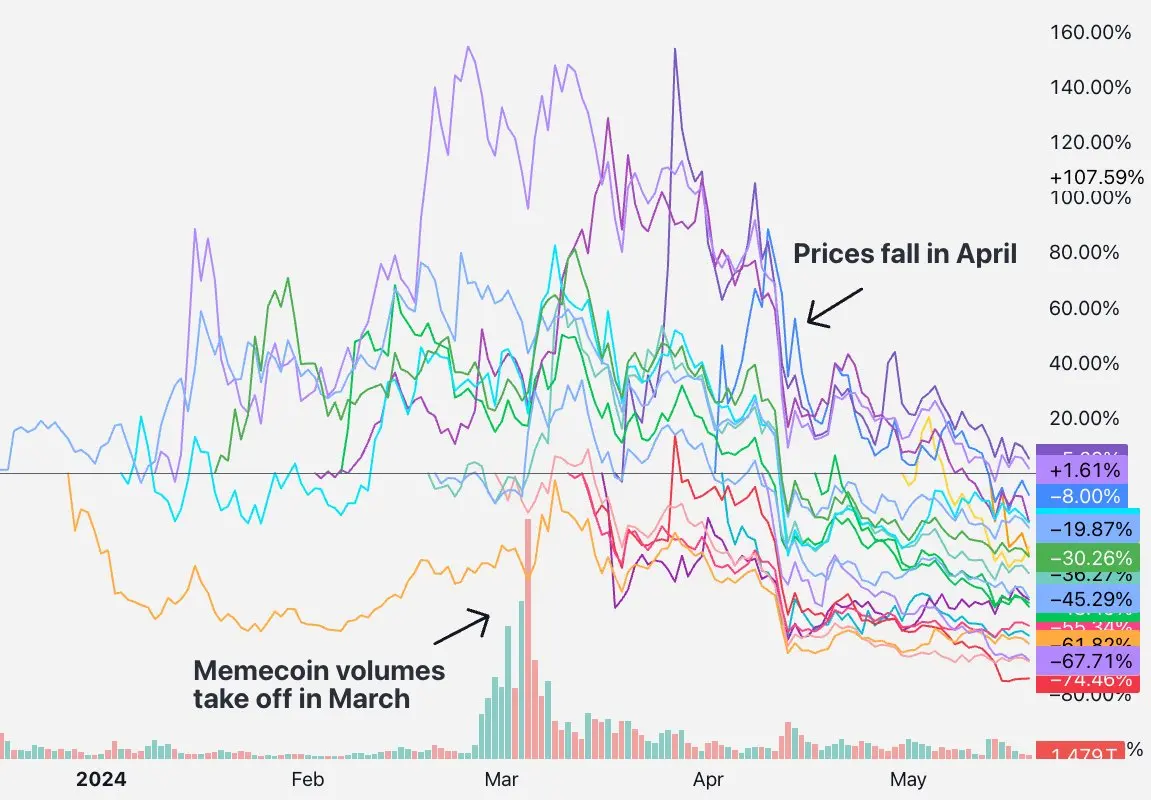
I plotted the trading volume of SHIB based on this basket of tokens. But the timing doesn’t match; by March, the frenzy for Memecoins had reached a crazy level, but a month and a half later in April, the entire basket was sold off.
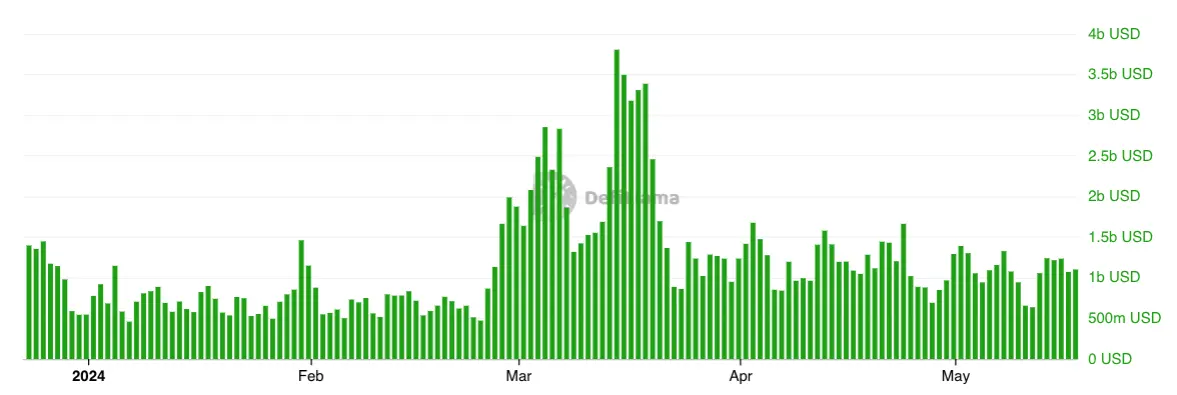
This is the trading volume on Solana DEX, telling the same story—meme coins exploded in early March, before mid-April.
So this also contradicts the data. After the depreciation of this basket of tokens, there was no significant shift towards meme coin trading. People are trading meme coins and new coins, and the trading volume does not indicate any clear change.
The issue is not with trading volume, but with asset prices.
That is to say, many people are trying to sell a story: the secondary market's illusion about real projects has shattered, and now it is mainly interested in meme coins. I visited Binance's Coingecko page and checked the top 50 trading volume tokens; today about 14.3% of Binance's trading volume is meme coin trading pairs. Meme coin trading is just a small part of what is happening in the cryptocurrency space. Financial nihilism is indeed a phenomenon and is very prominent in the crypto market, but most people in the world are still buying tokens because they believe in certain technological stories, whether they are right or wrong.
So, well, maybe retail investors shifting from VC tokens to meme coins is not literal, but here is a sub-theory: VCs own too many of these project tokens, which is why retail is angrily exiting. They realized (suddenly in mid-April?) that these are all scams, with VC tokens, teams + VCs owning about 30-50% of the token supply of these projects. This must be the last straw that broke the camel's back. This seems like a satisfying story.
But I have been doing cryptocurrency venture capital for a while. Here is a snapshot of token distribution from 2017-2020:
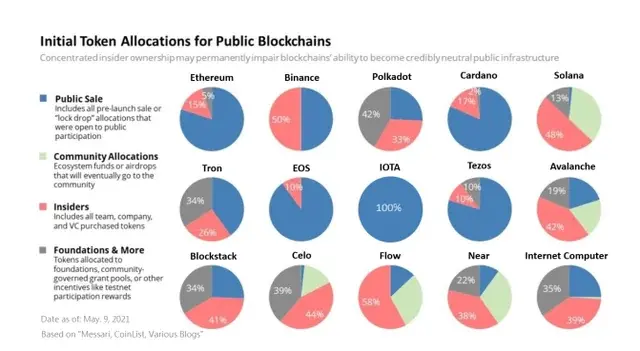
Look at the red shaded area—this is the proportion of insiders (teams + investors). SOL 48%, AVAX 42%, BNB 50%, STX 41%, NEAR 38%, etc. Today's situation is quite similar. So if the theory is "these tokens were not VC tokens in the past, but now they are," then this also contradicts the data. Regardless of the cycle, capital-intensive projects always face pending team and investor stakes at launch. Even after tokens are fully unlocked, these "venture capital tokens" still succeed.
In general, if what you are pointing to also happened in the previous cycle, then it cannot explain the unique phenomenon occurring now.
Thus, this story of "the secondary market angrily not picking up anymore, turning to trade meme coins" sounds very real and is a good satire, but it does not explain the data well.
Let's move on to the next theory.
3) The supply is too low for meaningful price discovery
This is the most common practice I have seen. It sounds good! It is less sensational, which is its advantage. Binance Research even published a good report to illustrate this issue:
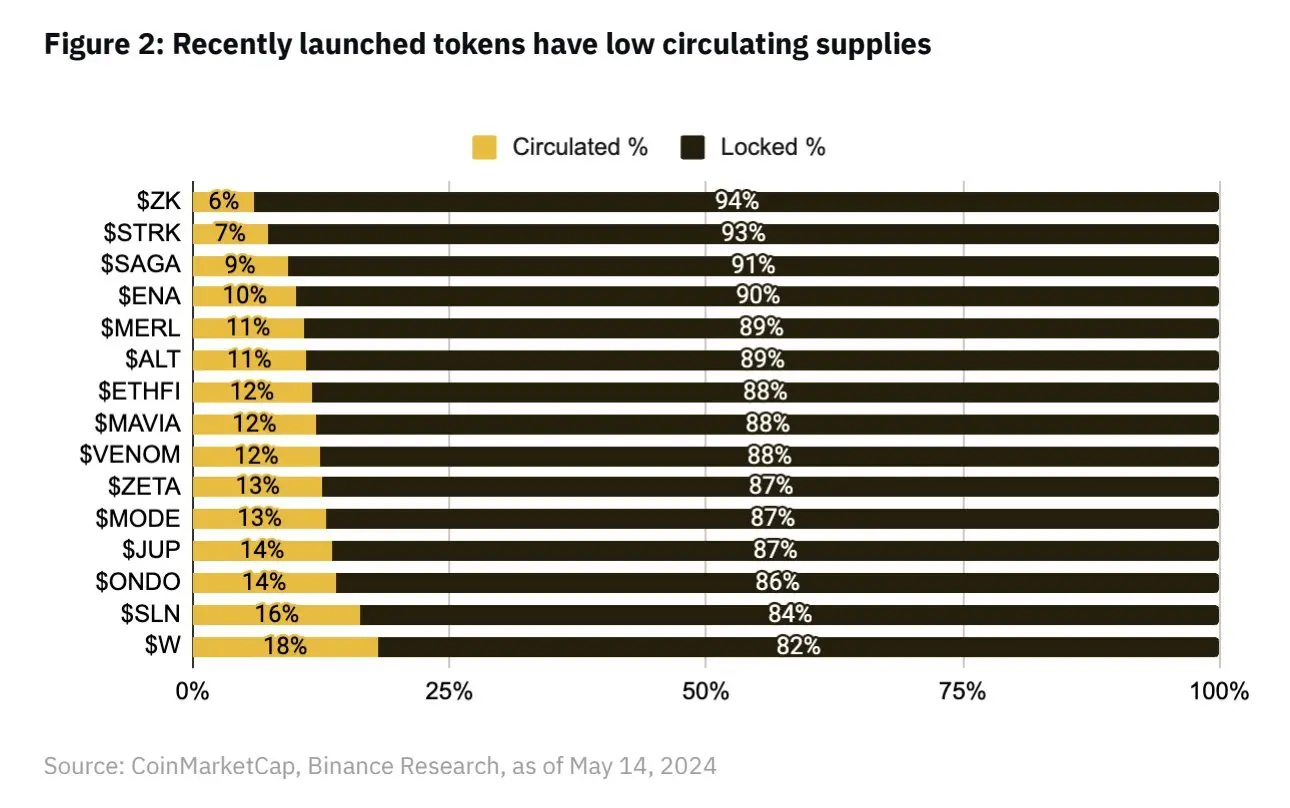
It looks like the average is about 13%. This is extremely low, obviously much lower than past tokens, right?
Is this the correct value?
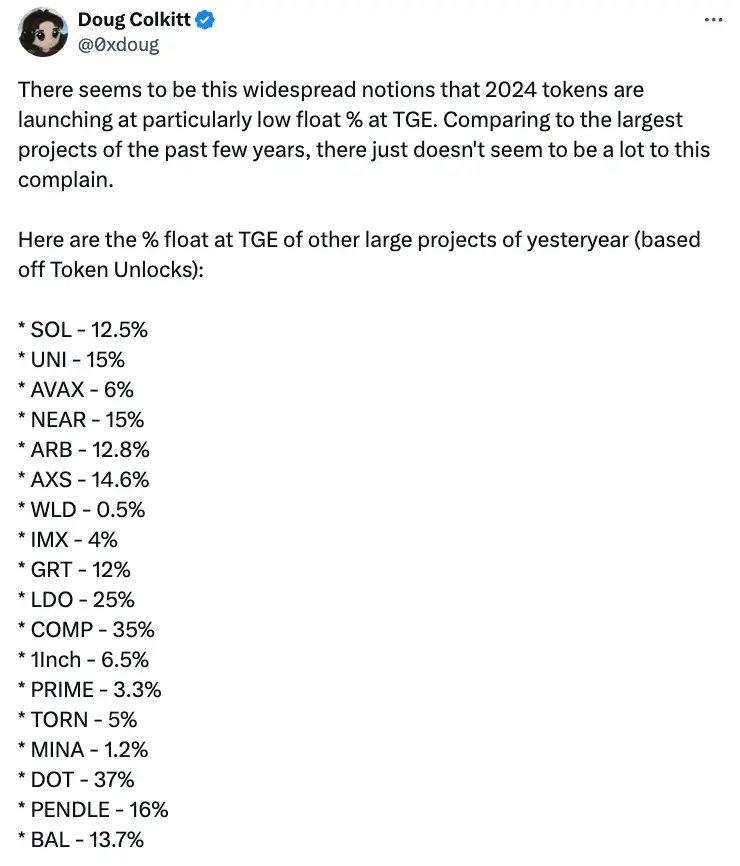
Thanks to @0xdoug for extracting this data. You guessed it, the average circulating supply of these tokens at TGE in the last cycle was 13%.
PS: In the same article from Binance Research, there is also a widely circulated image claiming that tokens launched in 2022 had an average circulating supply of 41% at launch.
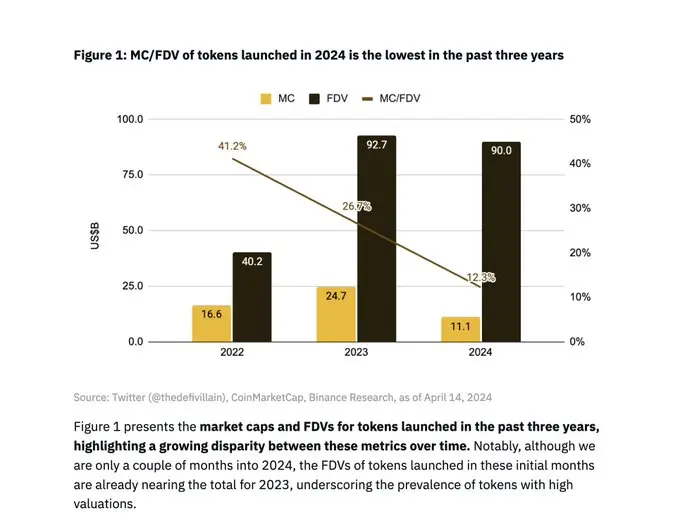
I'm sorry---WHAT? Around 2022, the circulating supply was already 41% before the project even launched.
I extracted the listings from Binance in 2022: OSMO, MAGIC, APT, GMX, STG, OP, LDO, MOB, NEXO, GAL, BSW, APE, KDA, GMT, ASTR, ALPINE, WOO, ANC, ACA, API3, LOKA, GLMR, ACH, IMX.
I randomly checked some of them, as not all have TokenUnlocks data: IMX, OP, and APE are similar to the latest batch of tokens we are comparing, where IMX had a circulating rate of 10% on the first day, APE had a first-day circulating rate of 27% (but 10% of that is APE treasury, so I rounded it to 17% circulating), and OP had a first-day circulating rate of 5%.
On the other hand, you also have LDO (55% unlocked) and OSMO (46% unlocked), but they were launched more than a year before being listed on Binance, so comparing these listings with the latest first-day listings is foolish. If I had to guess, these non-first-day listed tokens along with randomly issued company tokens like NEXO or ALPINE are why they have such high values. I don't think they are describing the true trend of real TGE------they are describing the trend of tokens listed on Binance after a year.
Well, maybe you would concede that a 13% circulating supply is similar to past cycles. But that is still too low for price discovery, right? And the stock market doesn't have this problem.
After all, just look at the median circulating supply on the first day of IPOs in 2023.
But seriously, low circulating supply is definitely an issue. WLD is a particularly shocking example, with a circulating supply of only 2%. FIL and ICP also had very low circulating supplies at launch, leading to very ugly price charts. But most tokens in the Binance group had their first-day fluctuations within historically normal ranges.
Additionally, if this theory is correct, you should see the coins with the lowest circulating supply being punished, while those with higher circulating supplies should perform well. But we did not see a strong correlation. They all fell.
Therefore, this story of lack of price discovery sounds very appealing, but after looking at the data, I do not believe it.
Solutions, Solutions
While everyone is complaining, a few have proposed actual solutions. Before discussing the null hypothesis, let's review them.
Many people suggest restoring ICOs. Sorry------did we forget the horrific situation of ICOs being sold off after listing and secondary market collapse? Moreover, ICOs are almost illegal everywhere, so I do not think this is a serious suggestion.
@KyleSamani believes that investors and teams should immediately unlock 100%------according to the 144a rule, this is impossible for US investors (and would also fuel the "VC dumping" events). Additionally, I think we recognized back in 2017 why team vesting is a good idea.
@arca believes that tokens should have book managers like traditional IPOs. I mean, maybe that would be useful? Token issuance is more akin to a direct listing, just listing on exchanges with some market makers, that’s it. I think that’s fine, but I lean towards simpler market structures and fewer intermediaries.
@reganbozman suggests that projects should list their tokens at lower prices so that retail can buy in earlier and gain some upside. I was inspired, but I think this won't work. Artificially lowering the price below the market clearing price means that anyone trading in the first minute on Binance will capture the incorrectly low pricing. We have seen this happen multiple times with NFT mints and IDOs. Artificially lowering your listing price will only benefit a few traders who fill orders in the first 10 minutes. If the market thinks your value is X, then in a free market, by the end of the day, your value will be X.
Some suggest we return to fair launches. Fair launches sound good in theory, but do not work well in practice because teams will just adjust quickly. Trust me, everyone tried this during DeFi summer. There are not many success stories here------besides Yearn, what other non-meme coins have successfully launched fairly in the past few years?
Many suggest teams conduct larger airdrops. I think this idea makes sense! We generally encourage teams to try to get more supply circulating on the first day to improve decentralization and price discovery. That said, I do not think that conducting ridiculous large-scale airdrops just for the sake of floating is a wise move------a protocol needs to do many things to handle its tokens after the first day to succeed, and promoting heavily for huge floating gains on listing day is not wise, as you will then have to compete for token revenue. You wouldn’t want to be one of those tokens that has to re-increase its token supply years later because your token treasury is empty.
So as VCs, what do we want to see happen here? Believe it or not, the token price in the first year reflects reality. We are not compensated through price profits (paper gains), but through DPI, which means we ultimately have to convert tokens into cash. We cannot eat paper markups, nor will we mark unvested tokens to market (anyone who does so in my view is crazy). For VC funds, having valuations reach astronomical numbers and then getting stuck after we unlock is actually a bad scheme. This leads LPs to believe this asset class is fraudulent------although it looks good on paper, it is actually terrible. We do not want this. We want asset prices to gradually and steadily rise over time, which is what most people hope for.
So, are these high FDVs sustainable? I don’t know. Compared to the numbers when projects like ETH, SOL, NEAR, and AVAX initially launched, these numbers are indeed staggering. But the scale of cryptocurrency is indeed larger now, and the market potential of successful crypto protocols is clearly greater than in the past.
@0xdoug mentioned an important point that if you normalize last year's altcoin FDV against today's ETH price, you get numbers very close to the FDV we are currently seeing. @Cobie echoed this in a recent post. We will not return to a $40 million L1 FDV because everyone sees how big the market is now. But when SOL and AVAX were released, the prices paid in the secondary market were comparable when adjusted based on ETH.
This frustration can largely be attributed to: cryptocurrency has risen significantly over the past 5 years. Startups are priced based on comparable companies, so the numbers will be larger. That’s it.
Well, so I easily criticize others' solutions. But what is my clever solution?
Honest answer?
Nothing. Leave it all to the market.
The free market will solve this problem itself. If tokens fall, then other tokens will be repriced lower, exchanges will push the teams behind to launch new projects at lower FDVs, and traders damaged in this cycle will only buy at lower prices, and VCs will pass this information on to new founders. Due to public market comparisons, B round pricing will decrease, punishing A round investors, ultimately affecting seed investors. Price signals will always be transmitted this way.
Similar situations have happened many times before. The market adapts and may only take a minute.
4) Null Hypothesis
Now let's unveil the Scooby Doo mask. What exactly happened that led to the decline of all tokens in April?
The culprit: the Middle East.
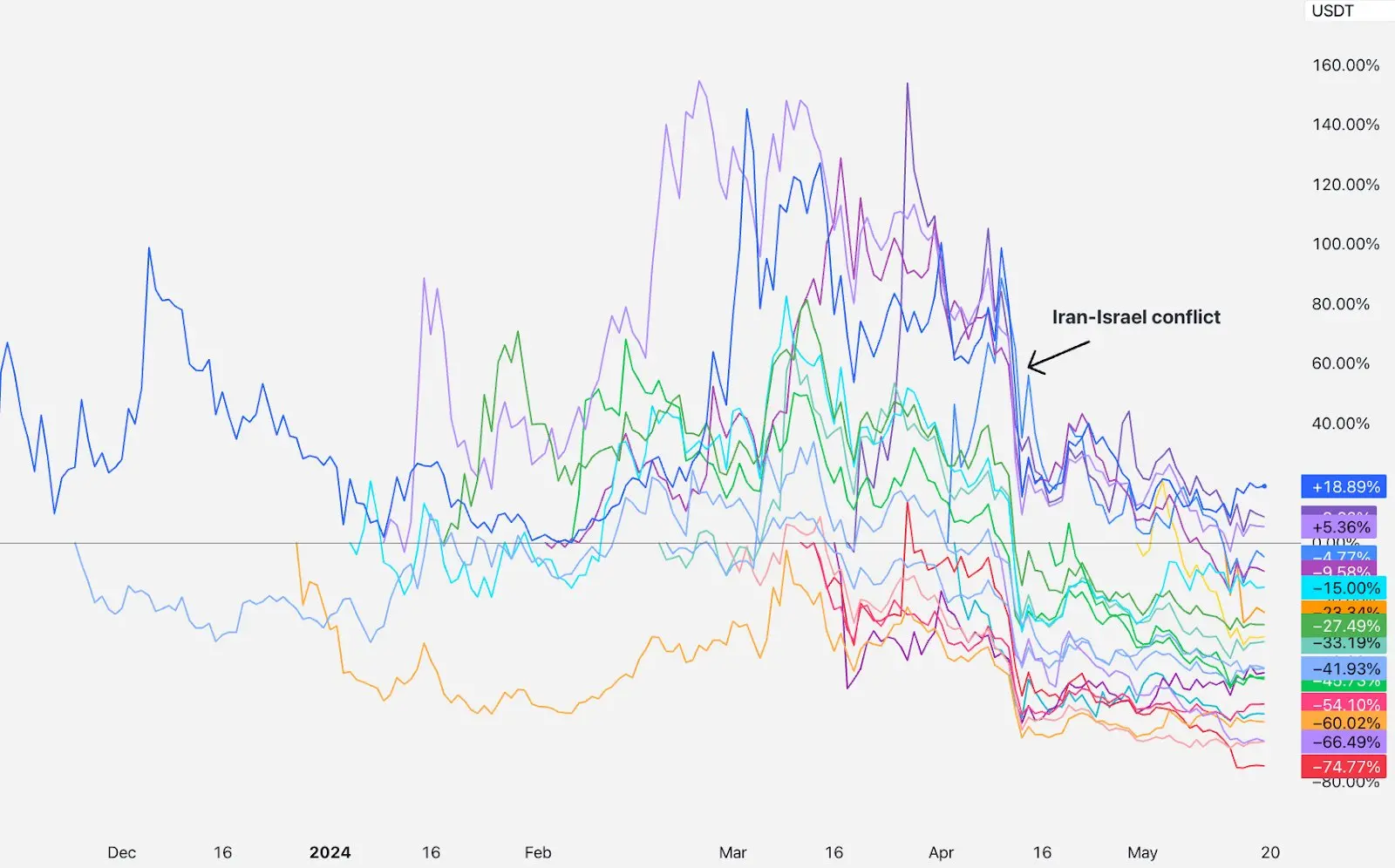
In the initial months, the trading of these tokens was mostly flat since listing until mid-April. Iran and Israel suddenly began threatening a third world war, and the market plummeted. Bitcoin's price rebounded, but these tokens did not.
So what is the best explanation for why these tokens are still down? My explanation is: these new projects are psychologically categorized as "high-risk new coins." Interest in the "high-risk new coin basket" declined in April and has not recovered. The market does not want to buy them back now.
Why?
I don’t know. The market can be fickle at times. But if this basket of "high-risk new coins" had risen by 50% during this period instead of falling by 50%, would you still argue about how the token market structure was broken? That would also be a mispricing, just in the opposite direction.
Mispricing is mispricing, and the market will ultimately fix it. If you want to help------sell things at crazy prices and buy things at better prices. If the market is wrong, it will self-correct. No need to do anything else.
What to do?
When people lose money, everyone wants to know who to blame. Is it the founders? VCs? KOLs? Traders? Market makers? Traders?
I think the best answer is no one or everyone. But thinking about market pricing errors from a blame perspective is not a productive framework. Therefore, I will elaborate on how people can do better in this new market regime.
VCs: Listen to the market's voice and slow down. Show pricing discipline. Encourage founders to have a realistic attitude towards valuations. Do not anchor your locked tokens to the market (as far as I know, almost all top VC firms hold locked tokens at prices significantly discounted from market prices). If you find yourself thinking, "I can't lose money on this deal," then you may regret this deal.
Exchanges: List new coins at lower prices. But you already know that. Consider using public auctions to price first-day tokens instead of pricing them based on the last round of venture capital valuations. Do not list new coins unless all investors/teams have contractual obligations not to hedge, and unless everyone (including KOLs) has market-standard lock-up periods. Better show retail the FDV burndown charts we all know and love, and spread more knowledge about unlocking.
Teams: Try to circulate more tokens on the first day! A token supply below 10% is too low.
Of course, have healthy airdrops, and do not be too afraid of low FDVs on the first day. The best price chart for building a healthy community is a gradually upward trend.
If your team's token has dropped, do not worry. You have good precedents to refer to. Remember:
AVAX dropped about 24% two months after listing;
SOL dropped about 35% two months after listing;
NEAR dropped about 47% two months after listing.
You will be fine. Focus on building content you can be proud of and continue delivering. The market will ultimately figure this out.
For you, please be wary of single-causal explanations; they are often not very accurate. The market is complex and can sometimes decline. Be skeptical of anyone who confidently claims to know the reasons. DYOR and do not invest anything you are not willing to lose.
Finally:
Thanks to @EvgenyGaevoy for reviewing the draft of this article.










